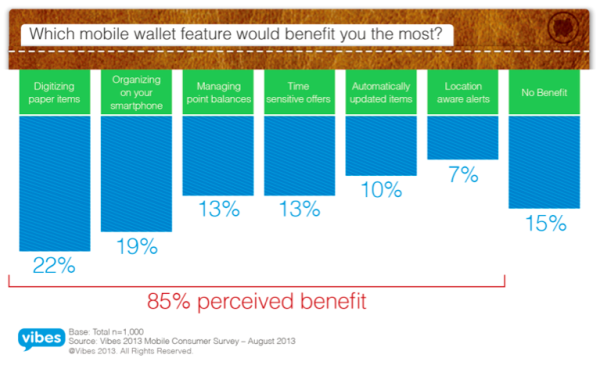Opening Mobile Wallet Opportunities For Marketers
There is a lot of buzz about mobile wallets — mostly, the challenges facing mass adoption of mobile payments. This has left many marketers to wonder how they will be able to implement innovative mobile payment technologies into their mobile/brand strategies. While the industry focuses its attention on m-payments (and lack thereof), marketers who want […]
There is a lot of buzz about mobile wallets — mostly, the challenges facing mass adoption of mobile payments. This has left many marketers to wonder how they will be able to implement innovative mobile payment technologies into their mobile/brand strategies.
While the industry focuses its attention on m-payments (and lack thereof), marketers who want to stand out have a unique opportunity to get ahead — with the non-payment side of mobile wallets.
It Starts With The Consumer
Consumers have made their preferences clear — they want a shopping companion. Mobile wallets eliminate the need for paper items (such as coupons and boarding passes), organize bulky items (such as loyalty cards), and expedite the check-out process at their favorite retailers. This desire and the fast-adoption reveal untapped potential, not necessarily in payments but in the non-payment side of the mobile wallet.
We are still in the early days of the mobile wallet transformation. The main landscape today is comprised of Apple’s Passbook, launched in September 2012, and Google Wallet, launched in 2013.
Despite the nascent market, consumers are eager and demand is high: Independent research of 1,000 smartphone users conducted in August 2013 showed that 85 percent of consumers believe they would receive some benefit from non-payment mobile wallets.
The explanation for this is simple: mobile makes consumers’ lives easier and more convenient. Why? Mobile wallets organize and simplify the overall shopping experience.
The Opportunity
Despite the perceived benefits, there are still plenty of non-users. The biggest challenge to date lies within a lack of education — and adoption — on behalf of both consumers and brands. For example, the research revealed that only 19 percent of smartphone owners have actually noticed retailers using mobile wallet-specific promotions.
This highlights a ripe opportunity for marketers. Mobile wallet apps offer a true symbiotic relationship alongside a retailer’s branded mobile app(s). There are few mobile marketing tools that complement each other as nicely and seamlessly as mobile wallet apps and a brand’s own app. (Check out our Mobile Wallet Handbook for more.)
The Proof Is In The Numbers
Data from more than 320 mobile wallet campaigns with leading retailers and brands show that, on average, 70 percent of consumers will save a Passbook offer to their phone when presented with a Pass. This visibility and access is just the beginning. When looking at conversion, mobile wallets have a 64-percent higher conversion rate over static mobile Web coupons.
For example, a clothing retailer using mobile wallets found the following statistics as a result of its campaigns:
- 78-percent increase add-to-wallet rate by shoppers who clicked through on a call-to-action (post-click engagement opportunity)
- 14-percent redemption rate in-store by shoppers who saved the offer to their wallet (increase in revenue)
- 72-percent offer retention rate after the offer expired (creating a perpetual presence on the phone)
Best Practices: How To Make (Non-Payments) Mobile Wallets Work
Do you want to create and execute a successful mobile wallet programs? Check out the best practices below, designed to optimize your efforts — and make your customers take notice and action.
1. Strategy: Define Your Mobile Wallet Objectives
Before you get started with mobile wallets, it’s critical to understand what you want to accomplish with the program and what content should be activated first. When you have identified the right offer or event, it’s equally important to understand what success looks like — and then set up the program to measure its effectiveness.
A great place to start is to look at currently planned promotions, big events or holidays. Is there a promotion that would work as a mobile wallet offer? Translating a print or online coupon into mobile wallet content is easy — and there is no downside to getting that content stored on your customers’ mobile phones.
Lastly, outline KPIs to measure each program. Test early and often in order to identify what works and what doesn’t.
2. Distribution: Use Multiple Marketing Levers To Distribute Content
Next, it’s time to get mobile wallet content onto consumers’ phones. Activate your existing marketing channels — text, mobile ads, apps/push, email, Web, direct mail and social — with a mobile wallet call-to-action.
Think about promotion strategy, and be sure to test and measure which methods and channels work best for your target audience. An easy way to do this is to assign different promotion codes or keywords to each channel. This allows you to close the loop from offer to channel to transaction, comparing average order value and redemption rates.
3. Design: Effective Mobile Wallet Design & Execution
While Google Wallet and Apple’s Passbook have similar approaches to presenting content, they are still distinctly different, each with its own design template.
Google Wallet has a uniform template with a few specific fields that can be personalized. The design features a continuous scroll and allows for clickable content such as a website, phone number or address.
Apple’s Passbook template has a defined front and back of the Pass, with multiple content fields allowing for personalized content. The consumer can flip the Pass over to receive additional information and links.
Continue to fine-tune your mobile strategy to increase customer engagement. As mobile wallets play an increasingly important role today, the next step for marketers is to leverage this vast opportunity to mobilize loyalty.
In my next article, I will take a look at how marketers can move beyond the trial period into providing customers with rich and personalized experiences to further build engagement and brand loyalty.
Opinions expressed in this article are those of the guest author and not necessarily MarTech. Staff authors are listed here.
Related stories

